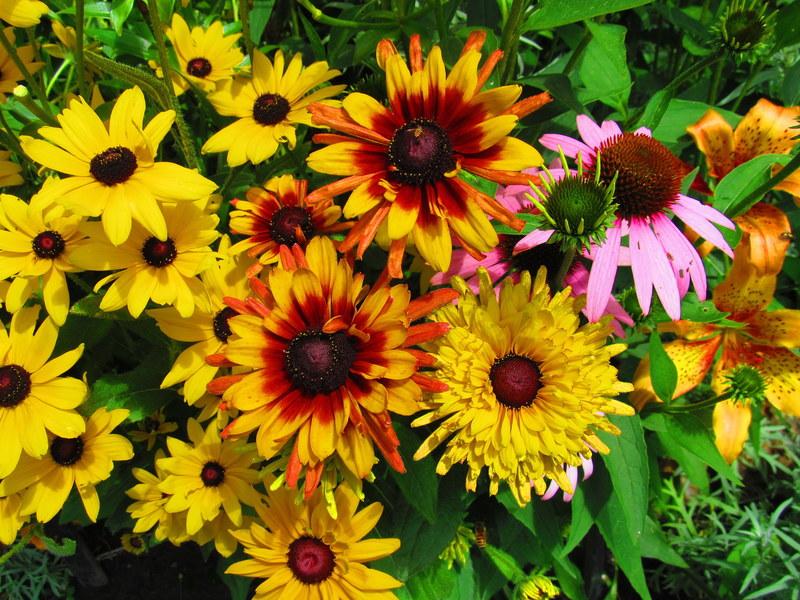Did you experience sticker shock when you went shopping for flowering perennials at local nurseries and garden centers this season? Our dreams of a garden overflowing with blossoms can sometimes get dashed when we begin to add up the cost of all those perennials in containers.

Here are some perennial choices that are easy to grow from seed and will add beautiful flowers in abundance to your garden. And now is an excellent time to get them started.
Easy from Seed Perennials
Not all perennials are good candidates for starting from seed. Some need to be propagated vegetatively- by division or cuttings- in order to produce cultivars or cultivated varieties that will be identical to the parent plant. But seeds of the flowers listed below are gardener-friendly. They are easy-to-grow choices that reward a little bit of effort with a lot of garden color.
Black Eyed Susan (Rudbeckia) - From summer to frost, the 2-3" gold-petaled, daisy-like flowers with dark centers add easy care color to the garden. Plants grow 25" tall. Direct seed in the garden spring through midsummer.
Blanket Flower (Gaillardia aristata) -With its spectacular, 3-4" yellow and red flowers, blanket flower provides plenty of color on 25-30" plants from June to frost. Easy to grow, they can be direct seeded in the garden.
'McKana's Giant Mix' Columbine (Aquilegia) - Large, spurred blossoms in shades of white, pink, violet and blue sway gracefully above a mound of ferny foliage. May be direct-seeded May through July for flowers the following spring.
Sweet William Mixture (Dianthus) - Large clusters of small, carnation-like flowers in a mix of white, pink and red on 15" tall plants add color to a sunny spot and provide blossoms for cutting. Can be direct seeded.
'Russell Mix' Lupine (Lupinus) - The tall spikes of flowers in this fancy mix bloom in pinks, blues and reds in June and July. Adaptable and easy to grow, the seeds of these 3' tall plants can be sown directly in the garden.
Purple Coneflower (Echinacea) - Blooming from midsummer until frost, this easy to grow perennial bears large, rose-pink, daisy-like flowers. Plants are heat and drought tolerant and have few insect or disease problems. Easy to direct sow.
Shasta Daisy (Leucanthemum x superbum) - Perfect for a sunny spot, these 18-20" tall plants are covered with white daisies with yellow centers in summer. Tolerant of tough growing conditions, their foliage is almost evergreen, especially in warmer areas. Can be direct sown in spring.
Three Ways for Starting from Seed
There are three different ways you can grow the perennials listed above from seed. The actual seed sowing technique is pretty much the same; it's the timing that varies. All are good strategies for making new plants for your garden. Pick the one that's most convenient for you or try them all!
Sow seeds directly in the garden in spring to early summer. This is probably the easiest method. Prepare a seedbed by mixing in organic material and raking the bed smooth. Sow plants where they are to grow or make a nursery bed for germinating seeds and growing plants on until they are large enough to move to their permanent location. (Lupines don't like to be moved, so it's best to sow them in their desired garden spot.)
Check the seed packet for specific information on germination needs. For example, seeds of blanket flower, columbine and Shasta daisy need light to germinate, so they should only be pressed into the surface of the soil, not covered. Lupines have a hard seed coat and germinate better if they are soaked in warm water for 24 hours or have their seed coat nicked before planting.
Keep the seed bed moist until the seeds begin to sprout, then thin according to the seed packet directions when seedlings are a couple of inches tall. If you started plants in a nursery bed, move them to their permanent location when they are 4-5 inches tall. If you planted in early spring, you may get blooms the first year from many of these plants.
Sow seeds early indoors. Sow seeds in flats or individual pots 6-8 weeks before the last frost date in your area. (Sow lupine seeds in peat pots so you won't disturb their roots when you plant the seedlings in the garden.) Move seedlings in flats to individual pots as they grow; keep plants under lights or in a sunny southern window. When the danger of frost is past, harden off seedlings and plant them outside.
Starting seeds early indoors will not only give you bigger plants to set out in the garden, but will increase your chances of getting flowers the first season.
Sow seeds in midsummer for bloom the following year. July is a time when gardeners get a break from spring's many garden chores and activities. Why not take advantage of that lull and start some perennial flower seeds? You can either direct seed in a nursery bed or start seeds in pots of flats as directed for indoor sowing. Only set the containers in a partially shaded spot outdoors- an empty cold frame with the top removed and covered a section of snow fence for shade works well. Keep the containers in a cold frame for the winter or mulch young plants in a nursery bed to protect them over the winter. Next spring you'll have good sized plants that will be ready to start blooming when you set them in their permanent location in the garden.